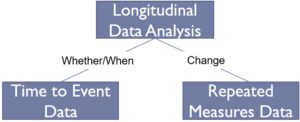How do you choose the best longitudinal data analytic method for testing your research questions?
 We have worked with statistical models for longitudinal data for more than two decades and this remains a vexing question to us both. There are so many modeling options from which to choose that it is often overwhelming to know which statistical method to use when. This is further complicated by the ongoing refinement of existing models and the development of wholly new models as each year passes. To help orient researchers to these many options, we recently presented a professional development workshop at the 2019 meeting of the Society for Research on Child Development titled Longitudinal Data Analysis: Knowing What to Do and Learning How to Do It and are pleased to make the materials for this workshop publicly available. We hope these materials help researchers identify which longitudinal data analysis techniques are best suited to test various kinds of hypotheses, and to decide among the many different training opportunities that exist for learning how to use these techniques with greater confidence.
We have worked with statistical models for longitudinal data for more than two decades and this remains a vexing question to us both. There are so many modeling options from which to choose that it is often overwhelming to know which statistical method to use when. This is further complicated by the ongoing refinement of existing models and the development of wholly new models as each year passes. To help orient researchers to these many options, we recently presented a professional development workshop at the 2019 meeting of the Society for Research on Child Development titled Longitudinal Data Analysis: Knowing What to Do and Learning How to Do It and are pleased to make the materials for this workshop publicly available. We hope these materials help researchers identify which longitudinal data analysis techniques are best suited to test various kinds of hypotheses, and to decide among the many different training opportunities that exist for learning how to use these techniques with greater confidence.
Over the course of the presentation, we develop a decision tree to help organize different types of analyses, their relations to one another, and what types of questions each method is best suited to answer. We begin by distinguishing models that evaluate “change” (e.g., growth models, GEE models, mixture models) from those that evaluate “whether and when” (e.g., survival analysis, hazard models, time series). We then systematically work down each of these pathways to explore specific models that allow for particular kinds of tests using particular kinds of data. We conclude with recommended strategies for how to select specific models for your own data as well as ways in which you might learn more about available data analytic options both inside and outside of the classroom.
To help disseminate these methods further, we’ve posted the workshop materials with our other online resources. One file is a PDF of the handout of our slides from the workshop, and another file contains the 86 individual PowerPoint slides that can be used for whatever purpose you please. We hope that these materials might be of use in your own work as well as potentially in classroom lectures or when working with students or colleagues.
We don’t intend our discussion to be either exhaustive or definitive. The analysis of longitudinal data is a topic that has evolved over a century of time and spans many scientific disciplines. There are many exceptions, alternatives, nuances, “what ifs”, and “but couldn’t yous” that aren’t addressed here. These materials simply capture our own view of the field and how we think about these methods and techniques in our own work. We hope that they might be of some use to you as well.

